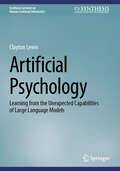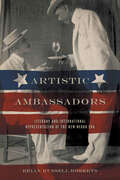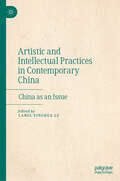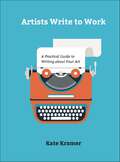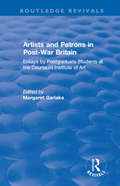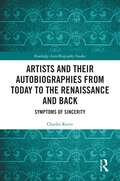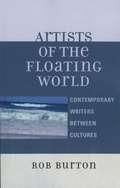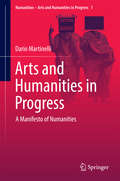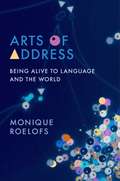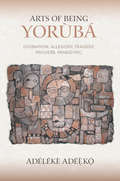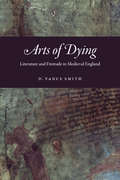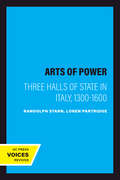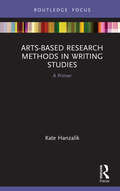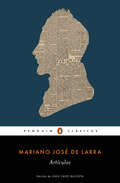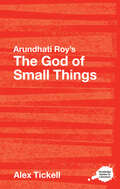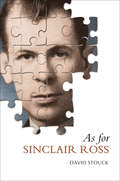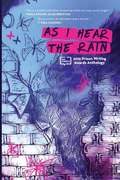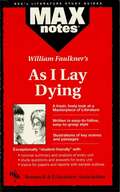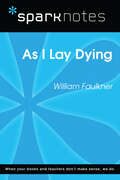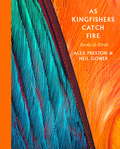- Table View
- List View
Artificial Psychology: Learning from the Unexpected Capabilities of Large Language Models (Synthesis Lectures on Human-Centered Informatics)
by Clayton LewisThe success of predictive large language models (PLLMs) like GPT3 and ChatGPT has created both enthusiasts and skeptics of their widespread practical applications, but this book argues that the larger significance of such models is contained in what they suggest about human cognition. To explore this potential, the book develops a thought experiment called the Prediction Room, a reference to John Searle’s influential Chinese Room argument, in which a human agent processes language by following a set of opaque written rules without possessing an inherent understanding of the language. The book proposes a new Room model—the Prediction Room with its resident Prediction Agent—generalizing the working of large language models. Working through a wide range of topics in cognitive science, the book challenges the conclusion of Searle’s thought experiment, that discredited contemporary artificial intelligences (AI), through the suggestion that the Prediction Room offers a means of exploring how new ideas in AI can provide productive alternatives to traditional understandings of human cognition. In considering the implications of this, the book reviews an array of topics and issues in cognitive science to uncover new ideas and reinforce older ideas about the mental mechanisms involved in both sides. The discussion of these topics in the book serves two purposes. First, it aims to stimulate new thinking about familiar topics like language acquisition or the nature and acquisition of concepts. Second, by contrasting human psychology with the form of artificial psychology these models exhibit, it uncovers how new directions in the development of these systems can be better explored.
Artistic Ambassadors: Literary and International Representation of the New Negro Era
by Brian Russell RobertsDuring the first generation of black participation in U.S. diplomacy in the late nineteenth and early twentieth centuries, a vibrant community of African American writers and cultural figures worked as U.S. representatives abroad. Through the literary and diplomatic dossiers of figures such as Frederick Douglass, James Weldon Johnson, Archibald and Angelina Grimké, W. E. B. Du Bois, Ida Gibbs Hunt, and Richard Wright, Brian Roberts shows how the intersection of black aesthetic trends and U.S. political culture both Americanized and internationalized the trope of the New Negro. This decades-long relationship began during the days of Reconstruction, and it flourished as U.S. presidents courted and rewarded their black voting constituencies by appointing black men as consuls and ministers to such locales as Liberia, Haiti, Madagascar, and Venezuela. These appointments changed the complexion of U.S. interactions with nations and colonies of color; in turn, state-sponsored black travel gave rise to literary works that imported international representation into New Negro discourse on aesthetics, race, and African American culture.Beyond offering a narrative of the formative dialogue between black transnationalism and U.S. international diplomacy, Artistic Ambassadors also illuminates a broader literary culture that reached both black and white America as well as the black diaspora and the wider world of people of color. In light of the U.S. appointments of its first two black secretaries of state and the election of its first black president, this complex representational legacy has continued relevance to our understanding of current American internationalism.
Artistic and Intellectual Practices in Contemporary China: China as an Issue
by Carol Yinghua LuThis edited volume is the first internationally available English translation of key lectures and essays delivered at Beijing’s Inside Out Art Museum over the past decade. The book elevates a chorus of voices from domestic and international intellectuals, artists, curators, and historians in a dialogue that reframes Chinese art from 1949 to the present.Part I offers critical academic complications of the story of Chinese art from the 1950s to the present as one singularly defined and stifled by political revolution. It traces important continuities and early examples of contemporary art practice to the Party’s birth and consolidation of power from the 1920s onwards. It relates the formation of contemporary art to the historical course of intellectual practice in China from 1949. Part II proposes China as an “issue” requiring historical interrogation rather than an inviolable entity. It questions the efficacy of “Asia” as a term, presents case studies of independentpublishers that challenged tightly crafted historical narratives, and wraps up with incisive reflections on the challenges confronting creatives and historians in China today.With chapters ranging from peer-reviewed scholarship to cuttingly humorous personal anecdotes, its contributing authors give rare, first-hand accounts of navigating pertinent historical and current situations, including censorship, China’s il/liberalism, and COVID-19. This book offers readers an ear to heretofore closed-door conversations in leading modern and contemporary art spaces.
Artists Write to Work: A Practical Guide to Writing about Your Art
by Kate KramerWriting and research strategies for documents every artist must craft: letters, applications, wall text, etc.Welcoming and effective, spells out clear connections between the writing process and creative practiceDestined to become an important addition to the libraries of art students, educators, and artists
Artists and Patrons in Post-war Britain
by Courtauld Institute of ArtThis title was first published in 2001. An examination of art and patronage in Britain during the post-war years. It consists of five case studies, initially written as MA theses, that closely investigate aspects of the mechanisms of patronage outside the state institutions, while indicating structural links within it. The writers have sought to elucidate the relationship between patronage, the production of art and its dissemination. Without seeking to provide an inclusive account of patronage or art production in the early post-war years, their disparate and highly selective papers set up models for the structure of patronage under specific historical conditions. They assume an understanding that works of art are embedded in their social contexts, are products of the conditions under which they were produced, and that these contexts and conditions are complex, fluid and imbricated in one another.
Artists and Their Autobiographies from Today to the Renaissance and Back: Symptoms of Sincerity (Routledge Auto/Biography Studies)
by Charles ReeveReading life writing that runs from Tracey Emin, Faith Ringgold and Judy Chicago to Marie Bashkirtseff, Benvenuto Cellini and beyond, Artists and Their Autobiographies from Today to the Renaissance and Back investigates the intriguing doubled truths of artists’ autobiographies: truth in life and truth in art; authorial truth/s and the truth of their art as they saw it. However, this book focuses specifically on the truth of sincerity, which here—following classic discussions by Reindert Dhondt, Philippe Lejeune and Lionel Trilling—appears as a truth to self that floats free from facts to link avowal and feeling. From there, this volume merges autobiography studies with a history of ideas approach to art to trace sincerity’s constancy and variability across times and cultures. Through this pre-disciplinary dialogue, this book shows that recent and historical artists’ autobiographies differ in how, not if, they intertwine sincerity in life and art. Along the way, this volume leverages the foregrounding of sincerity caused by this doubling to explore such key issues of autobiography studies as autobiography’s relation to fiction, serial autobiography, "as-told-to" narrative and what happens when liars claim to tell all.
Artists of the Floating World: Contemporary Writers Between Cultures
by Rob BurtonBurton (English, California State U., Chico) examines the fiction of four contemporary multicultural writers: Kazuo Ishiguro, Bessie Head, Bharati Mukherjee, and Salman Rushdie. His analysis centers on the unique ways in which each of the authors explores and articulates a literal and metaphorical "floating world" in which the boundaries between various binary opposites are blurred. Burton developed this idea of the floating world as a reinterpretation of the Japanese concept of ukiyo.
Arts and Humanities in Progress: A Manifesto of Numanities (Numanities - Arts and Humanities in Progress #1)
by Dario MartinelliThe book aims to introduce a research concept called "Numanities", as one possible attempt to overcome the current scientific, social and institutional crisis of the humanities. Such crisis involves their impact on, and role within, society; their popularity among students and scholars; and their identity as producers and promoters of knowledge. The modern western world and its economic policies have been identified as the strongest cause of such a crisis. Creating the conditions for, but in fact encouraging it. However, a self-critical assessment of the situation is called for. Our primary fault as humanists was that of stubbornly thinking that the world's changes could never really affect us, as - we felt - our identity was sacred. In the light of these approaches, the main strengths of humanities have been identified in the ability to: promote critical thinking and analytical reasoning; provide knowledge and understanding of democracy and social justice; develop leadership, cultural and ethical values. The main problems of humanities are the lack economic relevance; the socio-institutional perception of them as "impractical" and unemployable; the fact that they do not match with technological development. Finally, the resulting crisis consists mainly in the absence (or radical reduction) of funding from institutions; a decrease in student numbers a decrease in interest; a loss of centrality in society. A Numanities (New Humanities) project should consider all these aspects, with self-critical assessment on the first line. The goal is to unify the various fields, approaches and also potentials of the humanities in the context, dynamics and problems of current societies, and in an attempt to overcome the above-described crisis. Numanities are introduced not as a theoretical paradigm, but in terms of an "umbrella-concept" that has no specific scientific content in it: that particularly means that the many existing new fields and research trends that are addressing the same problems (post-humanism, transhumanism, transformational humanities, etc. ) are not competitors of Numanities, but rather possible ways to them. Therefore, more than a theoretical program, Numanities intend to pursue a mission, and that is summarized in a seven-point manifesto. In the light of these premises and reflections, the book then proceeds to identify the areas of inquiry that Numanities, in their functions and comprehensive approach, seek to cover. The following list should also be understood as a statement of purposes for this entire book series. These, in other words, will be the topics/areas we intend to represent. Once elaborated on the foundations of Numanities, the book features a second part that presents two case studies based on two relatively recent (and now updated) investigations that the author has performed in the fields of musical and animal studies respectively. The two cases (and relative areas of inquiry) were selected because they were considered particularly relevant within the discussion of Numanities, and in two different ways. In the first case-study the author discussed the most typical result (or perhaps cause?) of the technophobic attitude that was addressed in the first part of the book: the issue of "authenticity", as applied, in the author's particular study, to popular music. In the second case-study, he analyzes two different forms of comparative analysis between human and non-human cognition: like in the former case, this study, too, is aimed at a critical commentary on (what the author considers) redundant biases in current humanistic research - anthropocentrism and speciesism.
Arts of Address: Being Alive to Language and the World (Columbia Themes in Philosophy, Social Criticism, and the Arts)
by Monique RoelofsModes of address are forms of signification that we direct at living beings, things, and places, and they at us and at each other. Seeing is a form of address. So are speaking, singing, and painting. Initiating or responding to such calls, we participate in encounters with the world. Widely used yet less often examined in its own right, the notion of address cries out for analysis.Monique Roelofs offers a pathbreaking systematic model of the field of address and puts it to work in the arts, critical theory, and social life. She shows how address props up finely hewn modalities of relationality, agency, and normativity. Address exceeds a one-on-one pairing of cultural productions with their audiences. As ardently energizing tiny slippages and snippets as fueling larger impulses in the society, it activates and reaestheticizes registers of race, gender, class, coloniality, and cosmopolitanism. In readings of writers and artists ranging from Julio Cortázar to Jamaica Kincaid and from Martha Rosler to Pope.L, Roelofs demonstrates the centrality of address to freedom and a critical political aesthetics. Under the banner of a unified concept of address, Hume, Kant, and Foucault strike up conversations with Benjamin, Barthes, Althusser, Fanon, Anzaldúa, and Butler. Drawing on a wide array of artistic and theoretical sources and challenging disciplinary boundaries, the book illuminates address’s significance to cultural existence and to our reflexive aesthetic engagement in it. Keeping the reader on the lookout for flash fiction that pops up out of nowhere and for insurgent whisperings that take to the air, Arts of Address explores the aliveness of being alive.
Arts of Being Yoruba: Divination, Allegory, Tragedy, Proverb, Panegyric
by Adélékè AdéèkóThere is a culturally significant way of being Yorùbá that is expressed through dress, greetings, and celebrations—no matter where in the world they take place. Adélékè Adék documents Yorùbá patterns of behavior and articulates a philosophy of how to be Yorùbá in this innovative study. As he focuses on historical writings, Ifá divination practices, the use of proverbs in contemporary speech, photography, gendered ideas of dressing well, and the formalities of ceremony and speech at celebratory occasions, Adéékó contends that being Yorùbá is indeed an art and Yorùbá-ness is a dynamic phenomenon that responds to cultural shifts as Yorùbá people inhabit an increasingly globalized world.
Arts of Dying: Literature and Finitude in Medieval England
by D. Vance SmithPeople in the Middle Ages had chantry chapels, mortuary rolls, the daily observance of the Office of the Dead, and even purgatory—but they were still unable to talk about death. Their inability wasn’t due to religion, but philosophy: saying someone is dead is nonsense, as the person no longer is. The one thing that can talk about something that is not, as D. Vance Smith shows in this innovative, provocative book, is literature. Covering the emergence of English literature from the Old English to the late medieval periods, Arts of Dying argues that the problem of how to designate death produced a long tradition of literature about dying, which continues in the work of Heidegger, Blanchot, and Gillian Rose. Philosophy’s attempt to designate death’s impossibility is part of a literature that imagines a relationship with death, a literature that intensively and self-reflexively supposes that its very terms might solve the problem of the termination of life. A lyrical and elegiac exploration that combines medieval work on the philosophy of language with contemporary theorizing on death and dying, Arts of Dying is an important contribution to medieval studies, literary criticism, phenomenology, and continental philosophy.
Arts of Impoverishment: Beckett, Rothko, Resnais
by Leo Bersani Ulysse DutoitWhy taunt and flout us, as Beckett's writing does? Why discourage us from seeing, as Mark Rothko's paintings often can? Why immobilize and daze us, as Alain Resnais' films sometimes will? Why, Leo Bersnai and Ulysse Dutoit ask, would three acknowledged masters of their media make work deliberately opaque and inhospitable to an audience? This book shows how such crippling moves may signal a profoundly original - and profoundly anti-modernist - renunciation of art's authority.
Arts of Power: Three Halls of State in Italy, 1300-1600 (The New Historicism: Studies in Cultural Poetics #19)
by Randolph Starn Loren PartridgeThis title is part of UC Press's Voices Revived program, which commemorates University of California Press’s mission to seek out and cultivate the brightest minds and give them voice, reach, and impact. Drawing on a backlist dating to 1893, Voices Revived makes high-quality, peer-reviewed scholarship accessible once again using print-on-demand technology. This title was originally published in 1992.This title is part of UC Press's Voices Revived program, which commemorates University of California Press’s mission to seek out and cultivate the brightest minds and give them voice, reach, and impact. Drawing on a backlist dating to 1893, Voices Revived</DIV
Arts-Based Research Methods in Writing Studies: A Primer (Routledge Research in Writing Studies)
by Kate HanzalikAs the arts become an increasingly popular pedagogical tool in writing studies, Arts-Based Research Methods in Writing Studies offers scholars and educators in the field ways to leverage the arts for their own scholarship through the practice of arts-based research (ABR). Tailored to the needs of writing studies scholars, this concise guide presents ways of exploring and addressing unresolved research questions from the past as well as new, pressing questions that are emerging in light of increasingly fraught and complicated current contexts. It explores motives and methods for taking up ABR, sheds light on the processes of representing research and the ethical imperative of methodological disclosure, and looks critically at the complexities of fully realizing ABR in writing studies while offering some pedagogical applications. Connecting theory to practice, this book also performs ABR through a co-created mixed-media text about the everyday and extraordinary stories woven into the fabric of new American artists’ composing processes. Arts-Based Research Methods in Writing Studies lends itself to insight that is at once personal for writing studies researchers, useful for research communities, and a catalyst for social change beyond institutional walls; as such, it will be an important resource for scholars, educators, and graduate students in writing studies and those interested in multimodal, multilingual, and translingual learning; equitable pedagogies and administrative practices; online writing instruction; transnational literacies; research methods; community-based research; and disability studies in composition.
Artículos (Los mejores clásicos #Volumen)
by Mariano José LarraLos mejores libros jamás escritos Edición de Juan Cano Ballesta, catedrático emérito de literatura española de la Universidad de Virginia En Mariano José de Larra, considerado el primer gran periodista español, conviven una imbatible actitud crítica, heredada de los viejos ilustrados de nuestro país, y el apasionamiento romántico. Pocos aspectos de la realidad de la época se escapan a su mirada, y su afilada pluma se ejercita en el escarnio de errores políticos, de vicios privados, de pecados nacionales, de lacras sociales. Sus artículos son piezas modélicas por su desengañada ironía, por su profundidad, por la precisión y elegancia de su estilo, por el acierto en la elección de las anécdotas y por su pericia a la hora de relatarlas. Esta edición incluye una introducción que contextualiza la obra, un aparato de notas, una cronología y una bibliografía esencial, así como también varias propuestas de discusión y debate en torno a la lectura. Está al cuidado de Juan Cano Ballesta, catedrático emérito de la Universidad de Virginia (EE.UU.). «Nunca está el hombre más filósofo que en sus malos ratos.»
Arundhati Roy's The God of Small Things: A Routledge Study Guide (Routledge Guides to Literature)
by Alex TickellOn publication Arundhati Roy's first novel The God of Small Things (1997) rapidly became an international bestseller, winning the Booker Prize and creating a new space for Indian literature and culture within the arts, even as it courted controversy and divided critical opinion. This guide to Roy’s ground-breaking novel offers: an accessible introduction to the text and contexts of The God of Small Things a critical history, surveying the many interpretations of the text from publication to the present a selection of new essays and reprinted critical essays by Padmini Mongia, Aijaz Ahmad, Brinda Bose, Anna Clarke, Émilienne Baneth-Nouailhetas and Alex Tickell on The God of Small Things, providing a range of perspectives on the novel and extending the coverage of key critical approaches identified in the survey section cross-references between sections of the guide, in order to suggest links between texts, contexts and criticism suggestions for further reading. Part of the Routledge Guides to Literature series, this volume is essential reading for all those beginning detailed study of The God of Small Things and seeking not only a guide to the novel, but a way through the wealth of contextual and critical material that surrounds Roy's text.
As For Sinclair Ross
by David StouckSinclair Ross (1908-1996), best known for his canonical novel As for Me and My House (1941), and for such familiar short stories as "The Lamp at Noon" and "The Painted Door," is an elusive figure in Canadian literature. A master at portraying the hardships and harsh beauty of the Prairies during the Great Depression, Ross nevertheless received only modest attention from the public during his lifetime. His reluctance to give readings or interviews further contributed to this faint public perception of the man. In As for Sinclair Ross, David Stouck tells the story of a lonely childhood in rural Saskatchewan, of a long and unrewarding career in a bank, and of many failed attempts to be published and to find an audience. The book also tells the story of a man who fell in love with both men and women and who wrote from a position outside any single definition of gender and sexuality. Stouck's biography draws on archival records and on insights gathered during an acquaintance late in Ross's life to illuminate this difficult author, describing in detail the struggles of a gifted artist living in an inhospitable time and place. Stouck argues that when Ross was writing about prairie farmers and small towns, he wanted his readers to see the kind of society they were creating, to feel uncomfortable with religion as coercive rhetoric, prejudices based on race and ethnicity, and rigid notions of gender. As for Sinclair Ross is the story of a remarkable writer whose works continue to challenge us and are rightly considered classics of Canadian literature.
As Full As the World: Worktext
by Bju StaffEngage students with a variety of character-building stories as well as classical literature selections from which biblical principles are drawn. An emphasis on literary elements, higher-level thinking skills, and vocabulary enrichment is a bridge to the traditional literature classes that begin in junior high. The student text includes samples from classic authors Charles dinkens, Kenneth Grahame, Emily dinkinson, and Robert Browning.
As Full as the World: Reading 6 for Christian Schools® (Second Edition)
by Bju StaffWritten by members of the faculty and staff at Bob Jones University. Standing for the old time religion and the absolute authority of the Bible since 1927 . Bob Jones University is the world's leading Fundamentalist Christian University. The staff of the University is devoted to educating Christian men and women to be servants of Jesus Christ in all walks of life.
As I Hear The Rain (Pen America Prison Writing Awards Anthology Series #Volume 2)
by Robert Pollock Caits Meissner Tamara SantibanezMay this anthology serve a multitude of purposes: may it introduce new readers to exceptional works, may vividly depicted shared experiences speak to the other writers in this book, may the work inform those without relationship to anyone held in United States prisons, may a reader forget the work was written from prison, altogether. May this book inspire literary communities to more intentionally include the work of incarcerated writers, and may it lead to new paths for both writers and readers alike.
As I Lay Dying (MAXNotes Literature Guides)
by Wendy Ellen WaisalaREA's MAXnotes for William Faulkner's As I Lay Dying MAXnotes offer a fresh look at masterpieces of literature, presented in a lively and interesting fashion. Written by literary experts who currently teach the subject, MAXnotes will enhance your understanding and enjoyment of the work. MAXnotes are designed to stimulate independent thought about the literary work by raising various issues and thought-provoking ideas and questions. MAXnotes cover the essentials of what one should know about each work, including an overall summary, character lists, an explanation and discussion of the plot, the work's historical context, illustrations to convey the mood of the work, and a biography of the author. Each chapter is individually summarized and analyzed, and has study questions and answers.
As I Lay Dying (SparkNotes Literature Guide Series)
by SparkNotesAs I Lay Dying (SparkNotes Literature Guide) by William Faulkner Making the reading experience fun! Created by Harvard students for students everywhere, SparkNotes is a new breed of study guide: smarter, better, faster.Geared to what today's students need to know, SparkNotes provides:chapter-by-chapter analysis explanations of key themes, motifs, and symbols a review quiz and essay topics Lively and accessible, these guides are perfect for late-night studying and writing papers.
As Kingfishers Catch Fire: Birds & Books
by Neil Gower Alex Preston'Delightful . . . an original look at the literature inspired by Britain's birdlife' the Guardian, Best Nature Books of 2017'[The] pages light up with feathered magic' Evening StandardWhen Alex Preston was 15, he stopped being a birdwatcher. Adolescence and the scorn of his peers made him put away his binoculars, leave behind the nature reserves and the quiet companionship of his fellow birders. His love of birds didn't disappear though. Rather, it went underground, and he began birdwatching in the books that he read, creating his own personal anthology of nature writing that brought the birds of his childhood back to brilliant life. Looking for moments 'when heart and bird are one', Preston weaves the very best writing about birds into a personal narrative that is as much about the joy of reading and writing as it is about the thrill of wildlife. Beautifully illustrated and illuminated by the celebrated graphic artist Neil Gower, As Kingfishers Catch Fire is a book to love and to hold, to return to again and again, to marvel at the way that authors across the centuries have captured the endless grace and variety of birds. It will make you look at birds, at the world, in a newer, richer light.'A joyful and a wondrous book . . . Each bird illustrated by Gower in a mixture of gouache and watercolour that brings to mind both William Morris and Eric Ravilious' the Observer'I can see it under the Christmas tree of every family with a bird feeder and a copy of the RSPB Handbook . . . Preston captures his birds beautifully' The Times
As Kingfishers Catch Fire: Birds & Books
by Neil Gower Alex Preston'A magical book: an inimitable fusion of ornithology, literary anthology and autobiography.' Tom HollandWhen Alex Preston was 15, he stopped being a birdwatcher. Adolescence and the scorn of his peers made him put away his binoculars, leave behind the hides and the nature reserves and the quiet companionship of his fellow birders. His love of birds didn't disappear though. Rather, it went underground, and he began birdwatching in the books that he read, creating his own personal anthology of nature writing that brought the birds of his childhood back to brilliant life. Looking for moments 'when heart and bird are one', Preston weaves the very best writing about birds into a personal and eccentric narrative that is as much about the joy of reading and writing as it is about the thrill of wildlife. Moving from the 'high requiem' of Keats's nightingale to the crow-strewn sky at the end of Alan Garner's The Weirdstone of Brisingamen, from Ted Hughes's brooding 'Hawk in the Rain' to the giddy anthropomorphism of Jonathan Livingstone Seagull, this is a book that will make you look at birds, at the world, in a newer, richer light. Beautifully illustrated and illuminated by the celebrated graphic artist Neil Gower, As Kingfishers Catch Fire is a book to love and to hold, to return to again and again, to marvel at the way that authors across the centuries have captured the endless grace and variety of birds.'A joyful and a wondrous book' the Guardian
